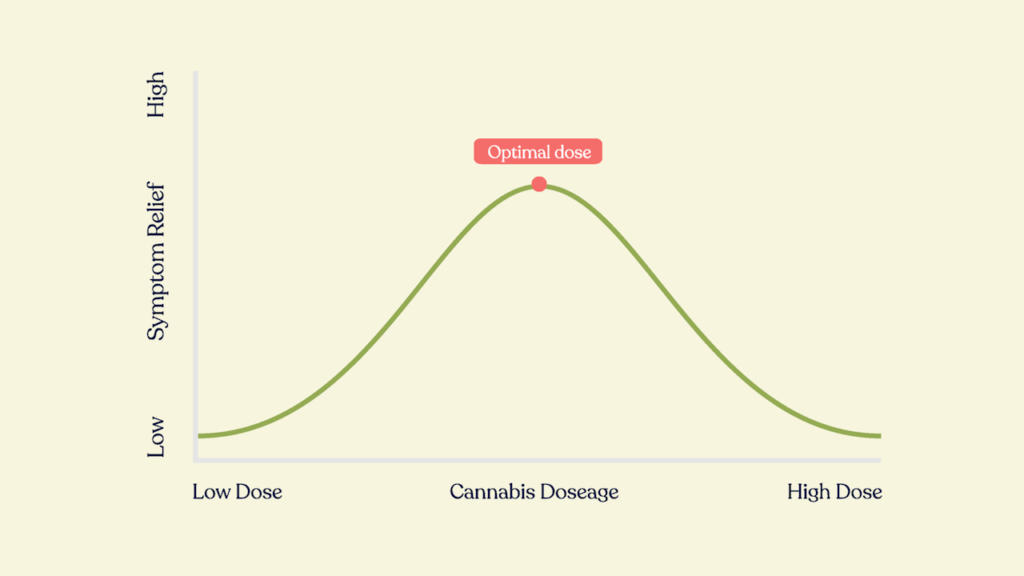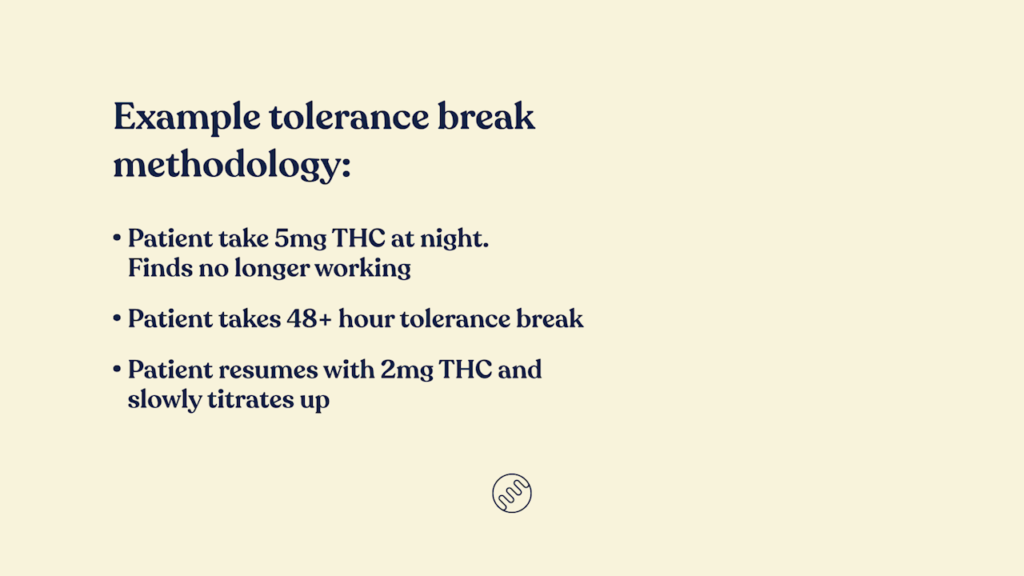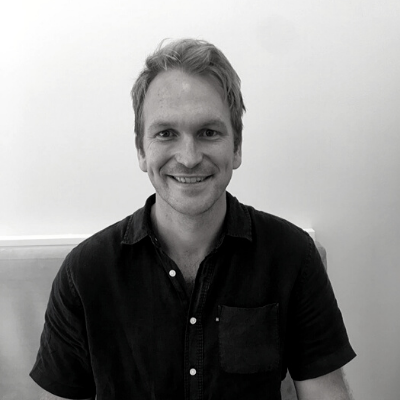Understanding cannabis / marijuana tolerance breaks
When people first hear about tolerance breaks they often think of “weed tolerance breaks” and that it’s only for recreational consumers. However, tolerance breaks (aka T-breaks) can be helpful for anyone who consumes cannabis regularly.
When consuming cannabis for medicinal, health or wellness purposes, the idea is to use the right amount to help optimise your body’s homeostasis or balance. And, that ‘right amount’ is different for everyone and depends on various factors. The right amount may also change over time due to your body building up a tolerance to certain cannabinoids.
To put it simply, a tolerance break is abstaining from using THC based products or medications for a period of time. Some people recommend a one-week tolerance break while others recommend a one-month tolerance break.
While there is no research defining the exact duration for a tolerance break, a study published in 2015 shows that after about 48 hours, the endocannabinoid receptors have already started to reset. As a result, the it’s generally accepted that 48+ hours is a good tolerance break.
However, if you’ve been a cannabis consumer for a long period of time or have been taking high doses of THC for an extended period of time you may need longer to get back to optimal endocannabinoid system functioning.
For medical cannabis patients who are treating a chronic illness, you need to balance your period of abstinence and making sure your symptoms don’t get out of control. It’s also important to note that individuals who use CBD only products or products that are mostly CBD are unlikely to need a T-break. Finally, you can build a tolerance to both THC and to the specific strain of cannabis.
In this article you’ll learn the following:
- 00:26 | How cannabis works on your body
- 02:04 | The importance of tolerance breaks
- 03:46 | What is a tolerance break?
- 04:38 | Signs you may need a tolerance break
- 05:31 | How to take a tolerance break
- 06:36 | Restarting THC based medications and products
- 07:29 | Example of T-break doses
- 08:24 | Tolerance to a strain of cannabis
How cannabis works on your body
Cannabis is a complex herbal medicine. Research shows that there are over 400 chemicals and upwards of 700 active compounds that have been isolated within the cannabis plant. The two best-known cannabinoids are CBD and THC. These chemicals work very differently.

CBD works through a myriad of neurotransmitters, enzymes and receptors. While it does upregulate the body’s own endocannabinoid function, it does not directly stimulate the CB1 or CB2 receptors.
THC is similar to one of our body’s own natural cannabinoids, Anandamide, and works as an agonist (stimulator) on the CB1 and CB2 receptors. Because THC acts directly on those receptors, too much THC can overwhelm the receptors and cause their functioning to be reduced. This is why you may need a tolerance break.
Because CBD doesn’t interact with your endocannabinoid receptors or directly with your endocannabinoid system (ECS), you don’t need a tolerance break to CBD.
The importance of tolerance breaks
The ECS is extremely important in the maintenance of homeostasis, or balance, within your body. It’s involved in multiple essential functions such as sleep, regulating pain, stress, your digestive system and many other functions. Having a well functioning ECS is important for optimal health.
It’s believed that most chronic disease states have a deficiency in the endocannabinoid system and its function. This deficiency is called clinical endocannabinoid deficiency. Both CBD and THC can be beneficial in improving the endocannabinoid tone or improving the body’s own endocannabinoid function.
But, because THC works directly on the cannabinoid receptors it can overwhelm the system thus reducing the amount of cannabinoids your body produces naturally. So, THC must be used in a way that improves ECS rather than causing dysfunction. Tolerance breaks can help reset the system to help it function optimally.
What is a cannabis tolerance break?
A tolerance break is abstaining from using THC based cannabis products or medications for a period of time. While there is no research defining the exact duration for a tolerance break, a study published in 2015 shows that after about 48 hours, the endocannabinoid receptors have already started to reset. As a result, it’s generally accepted that 48+ hours is a good tolerance break.
Prescribed flower?
Learn about the laws around consuming your medication in public. Read our smoking and vaping medicinal cannabis in public article.
Signs you may need a tolerance break

For medical cannabis patients, the main sign that you might need a tolerance break is when you notice that you’re getting less of a result from symptom control on the same dose of medication. So, if you start consuming an increasing dose of THC based medication to get the same effects, it may be an indication you’re building a tolerance to THC.
For those consuming cannabis for adult use purposes, you’ll likely see an increase in consumption with limited increase in your desired result (ie. relaxation or feeling uplifted).
It’s important to remember that with THC specifically, more doesn’t mean better or more effective. Because of how THC interacts with the body and receptors, at a certain stage, increasing your THC may have negative effects on your body as well as your ability to function.
How to take a tolerance break
For individuals consuming medicinal cannabis, it’s important to remind you that a T-break should be done under the guidance of the physician who prescribed your medicine. It’s also important to remind you that tolerance breaks don’t apply to individuals who are taking CBD only cannabis.
Abstaining from THC
It’s always best to start by planning your tolerance break. Some individuals feel strong effects when cutting out THC completely. Make sure you take your T-break when you don’t have too much going on so that you can be mindful of your body and health throughout the process. We recommend doing a T-break on the weekend or when you don’t have too much work to do.
The tolerance break itself is simple. Choose a start and end date. And, during that time, do not take any THC containing cannabis products.
Restarting your THC products
After you’ve done the 48+ hour break, it’s important to restart your dosing at about 50% of the dose of what was previously an effective therapeutic dose for you.
“Once you’ve cut down to 50% of your original dose, it’s likely that this lower dose will still be suboptimal for treating your symptoms. From 50% of the original dose you should titrate back up very slowly. Take a bit more cannabis each day or each dose and do this in a very mindful and reflective manner.”
If you follow this process, you should be able to get back to your original dose or even a bit lower and still have those therapeutic effects.
An example:

“Here’s an example. So, someone who was previously using five milligrams of THC at night time finds that it’s no longer effective for treating the symptoms. Instead of increasing their dose, I might recommend a tolerance break. After the 48 hours, they can start at two milligrams of THC at night.
We might increase them by one milligram a day. At three milligrams they may start to get some benefit. And then, hopefully, at four milligrams they will notice benefits similar to what they were experiencing previously.”
Tips for taking a tolerance break
Take CBD during tolerance breaks
If you’re prescribed or taking a CBD only (isolate) product as well as a THC product then it’s important to continue taking your CBD during the break. You may also want to consult with your doctor about temporarily increasing the dose of CBD during this period. Increased CBD may have an impact on some of the symptoms you’ve been relieving with the THC products.
Do things that naturally upregulate your ECS
It’s also a great time to support your ECS even more through other natural methods. Plan to do things like meditation, yoga, other exercises you enjoy. Eating healthy and increasing your sleep during this period may also help your ECS reset more quickly. Stay away from things that increase inflammation like alcohol and tobacco.
Tolerance to strains of cannabis
Some people may find that they’ve done their break and titrated back up but aren’t getting the same benefits as before. If this happens, there is a possibility that you’ve developed a tolerance to the particular strain or formulation that you’ve been using.
If you’re a patient and you’re having this problem, it’s important to speak with your doctor about changing to a different formula but a similar product to see how things go.
Conclusion
Tolerance breaks can be an important part of any cannabinoid treatment regime. If you are finding that you’re no longer getting the same therapeutic benefit from your cannabis, you may want to think about a tolerance break.
If you’re a medical cannabis patient, speak with your doctor about the pros and cons of a T-break. If treating a chronic condition, make sure that you have the support of your physician and those around you to support you through the break period. It’s important that you don’t have any significant relapses in your condition or symptoms.



